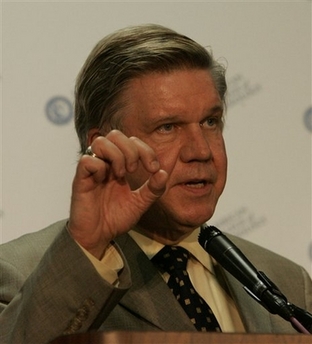Most angioplasties unneeded - Study
(AP)Updated: 2007-03-27 15:03
NEW ORLEANS - More than half a million people a year with chest pain are getting an unnecessary or premature procedure to unclog their arteries because drugs are just as effective, suggests a landmark study that challenges one of the most common practices in heart care.
 William E. Boden, M.D. shows the shape of a stent as he speaks to the media at the 56th Annual American Cardiology Conference Scientific session in New Orleans, Monday, March 26, 2007. [AP]  |
An even bigger surprise: Angioplasty gave only slight and temporary relief from chest pain, the main reason it is done.
"By five years, there was really no significant difference" in symptoms, said Dr. William Boden of Buffalo General Hospital in New York. "Few would have expected such results."
He led the study and gave results Monday at a meeting of the American College of Cardiology. They also were published online by the New England Journal of Medicine and will be in the April 12 issue.
Angioplasty remains the top treatment for people having a heart attack or hospitalized with worsening symptoms. But most angioplasties are done on a non-emergency basis, to relieve chest pain caused by clogged arteries crimping the heart's blood supply.
Those patients now should try drugs first, experts say. If that does not help, they can consider angioplasty or bypass surgery, which unlike angioplasty, does save lives, prevent heart attacks and give lasting chest pain relief.
In the study, only one-third of the people treated with drugs ultimately needed angioplasty or a bypass.
"You are not putting yourself at risk of death or heart attack if you defer," and considering the safety worries about heart stents used to keep arteries open after angioplasty, it may be wise to wait, said Dr. Steven Nissen, a Cleveland Clinic heart specialist and president of the College of Cardiology.
Why did angioplasty not help more?
It fixes only one blockage at a time whereas drugs affect all the arteries, experts said. Also, the clogs treated with angioplasty are not the really dangerous kind.
"Even though it goes against intuition, the blockages that are severe that cause chest pain are less likely to be the source of a heart attack than segments in the artery that are not severely blocked," said Dr. David Maron, a Vanderbilt University cardiologist who helped lead the new study.
Drugs are better today than they used to be, and do a surprisingly good job, said Dr. Elizabeth Nabel, director of the National Heart, Lung and Blood Institute.
"It may not be as bad as we thought" to leave the artery alone, she said.
About 1.2 million angioplasties are done in the United States each year. Through a blood vessel in the groin, doctors snake a tube to a blocked heart artery. A tiny balloon is inflated to flatten the clog and a mesh scaffold stent is usually placed.
The procedure already has lost some popularity because of emerging evidence that popular drug-coated stents can raise the risk of blood clots months later. The new study shifts the argument from which type of stent to use to whether to do the procedure at all.
It involved 2,287 patients throughout the US and Canada who had substantial blockages, typically in two arteries, but were medically stable. They had an average of 10 chest pain episodes a week - moderately severe. About 40 percent had a prior heart attack.
"We deliberately chose to enroll a sicker, more symptomatic group" to give angioplasty a good chance to prove itself, Boden said.
All were treated with medicines that improve chest pain and heart and artery health such as aspirin, cholesterol-lowering statins, nitrates, ACE inhibitors, beta-blockers and calcium channel blockers. All also were counseled on healthy lifestyles - diet, exercise and smoking cessation.
Half of the participants also were assigned to get angioplasty.
After an average of 4 1/2 years, the groups had similar rates of death and heart attack: 211 in the angioplasty group and 202 in the medication group - about 19 percent of each.
Heart-related hospitalization rates were similar, too.
Neither treatment proved better for any subgroups like smokers, diabetics, or older or sicker people.
At the start of the study, 80 percent had chest pain. Three years into it, 72 percent of the angioplasty group was free of this symptom as was 67 percent of the drug group.
That means you would have to give angioplasties to 20
people for every one whose chest pain was better after three years - an
unacceptably high ratio, Nissen said.
| 1 | 2 |  |
|
||
|
||
|
|